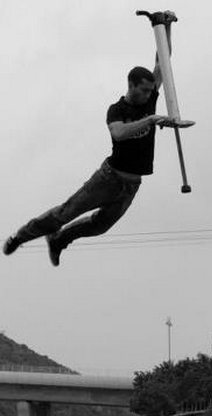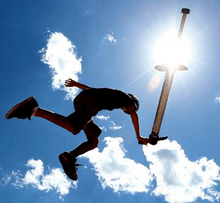Extreme Pogo
Extreme Pogo or Xpogo is an action sport which involves riding and performing tricks on specially designed "extreme" pogo sticks. Today’s Xpogo sticks have the potential for over 10 ft. of height (measured from the ground to the bottom of the tip).[1] Extreme pogo is a relatively new and popular extreme sport.[2] Xpogo can be seen in athlete exhibition teams,[3] Xpogo content on sites such as YouTube,[4] and the annual Pogopalooza: The Xpogo World Championship Series.[5]
Xpogo competitions have begun in countries outside of the USA.[6] An Xpogo commercial was run by Nike during the London Olympics.[7] Xpogo athletes were included in the 2014 Rose Parade in Pasadena, CA.[8] The vast majority of Xpogo athletes are male and between the ages of 10-25.[9]
History
Beginnings
The beginnings of Xpogo are somewhat contested, but it is acknowledged among the Xpogo community that Dave Armstrong from Provo, Utah was likely the first individual in the 20th century to make a conscious and consistent effort to execute tricks on a traditional steel spring pogo stick, beginning in 1999.[10] Dave created a website - Xpogo.com - around that time to share pictures and video of his bouncing. Shortly after Dave, several other individuals began to independently form the idea of creating an extreme sport around pogo. Among these individuals were Nick McClintock, Nick Ryan, Fred Grzybowski, Dan Brown, Rick Gorge, and Matt Malcolm. Each believing they had solely created a sport, the collective founders of Xpogo eventually connected via Xpogo.com.[11] Together they shared their tricks and associated media, effectively laying the groundwork for the sport as a whole.
Classic Sticks
From 2000 – 2004, pockets of Xpogo athletes began to emerge around the United States, and internationally in places like the Netherlands, inspired by Xpogo.com.[2] During this time there were no Xpogo sticks, only traditional steel spring sticks that could be purchased at retailers like Wal-Mart, Toys ‘R’ Us, and Amazon.com. Each pocket of jumpers took their own names and made associated websites to help define themselves against the larger Xpogo community. These groups included "Team Xpogo" "Team Hyper Pogo," "Pogo Cult," “Rittman Pogo,” “Grand Theft Pogo,” “Say No To Park,”and the largest group called “The Pogo Squad” from York, PA.[12]
As each of these groups developed, and motivated other individuals around the country to begin bouncing as well, a core group of tricks were created that served as the building blocks for all trick innovation to come. A series of grabs, stalls, spins, and wraps utilizing the two foot pegs, two handlebars, and the frame of the pogo stick became the commonly executed tricks.[13] Simple descriptive names such as “One-Foot Peg Grab” or “Under The Leg Bar Spin” were used to describe some tricks, while others received more specialized names such as “Malcolm X” (180 no-foot peg grab) and “Candy Bar” (one leg between the handlebars while jumping).[14] Other tricks were born out of common BMX or Skateboarding tricks such as “Can-Can,” and “Heel Clicker”.[2]

Prior to the advent of social media sites such as YouTube and Facebook, the majority of the communication and media sharing among extreme pogo enthusiasts occurred on Xpogo forums where, by 2004 there were 50-100 dedicated users and many more casual or “silent” users.[15] Due to the continued growth of the online community and the sport as a whole, member Dan Brown decided to hold an event called “Pogopalooza” where some of the top individuals in the sport could come together in person and hold a miniature competition and exposition of the sport.[16] In the summer of 2004 Dan Brown hosted “Pogopalooza 1” in the modest setting of a church parking lot in Nebraska where about seven members of the Xpogo community made appearances.[17] While the event was small in scope and only drew friends and family, it set the precedent to hold an annual event bringing together extreme pogo athletes from around the country, and eventually the world.[1]
Extreme Sticks
2004 was the first year "extreme" pogo sticks were available.[18] Defined as being able to support riders of adult weights while carrying a height potential of 6+ feet, the first extreme pogo stick was the Flybar 1200, by S.B.I. Enterprises.[18] Instead of using a traditional steel spring, the Flybar utilized giant rubber “elastomers,” creating a bungee-like jumping sensation. The new height potential made possible by the Flybar created a new era of trick development, noted most by the first full backflip on a pogo stick, landed by Brian “Chewy” Call in the fall of 2005.[19]
Shortly after the release of the Flybar, a company emerged in Southern California with the “MotoStik” pogo, which used a dual-spring technology with MotoX-style handlebars designed for cross-training.[20] The next extreme pogo stick on the scene, the Vurtego, arrived in 2006. Featuring a 3:1 patented air-compression technology the Vurtego produced the greatest height of any stick to date along with the greatest durability.[21] In 2008 the BowGo, which had been in development since 2001 at Carnegie Mellon University entered the fray.[22] Using a giant fiberglass bow on the front end of the pogo stick which flexed outward with downward pressure and snapped back in to produce upward momentum, the BowGo launched riders higher more consistently than any stick to date.[22] The TK8 pogo stick, another air compressed design launched in France and Andorra around 2010.[23] The top Xpogo athletes nationally worked in parallel with extreme pogo companies across the years to help sticks reach their full development potential[24]
The combination of the release of several extreme pogo sticks, along with the associated boom in creativity made possible by 6–9 ft. of air potential, the surge in information sharing potential through social media, and the continued steady growth of Xpogo.com brought a new and robust definition to the sport of Xpogo.[1][2]
Pogopalooza 6 + Beyond
By 2009, the Xpogo community had grown into the hundreds with hundreds to potentially thousands more followers and fans globally.[25][26] Pogopalooza had occurred 4 additional times in 2005, 2006, 2007, and 2008, increasing in scope and attendance each year[[27] ]. Pogopalooza 6, which was held in Pittsburgh, PA saw the biggest turnout of athletes yet, over 50+ from across the United States, Canada, and England and involved the whole of the City through four days of events and competition.[28]
Post-Pogopalooza 6 national media began to take note of extreme pogo in the biggest manner to date. The Wall Street Journal ran a front-page article on the sport and numerous other countrywide and even international publications began covering athletes, events, and the growth of Xpogo in general.[28] With the media push, more athletes began to emerge around the country and the globe, pushing trick innovation to new levels[29]
Pogopalooza 2014 + Beyond
After a widely attended and covered Pogopalooza 10 in New York City in 2013, the Pogopalooza competition expanded into a multi-city international touring format for 2014. Today, the event is referred to as "Pogopalooza: The Xpogo World Championship Series" and occurs multiple times throughout the year in cities around the world.[30]
Read the full article about Pogopalooza: The Xpogo World Championship Series for more information.
Xpogo LLC
In June 2010, three of sport’s original founders, Nick Ryan, Nick McClintock, and Fred Grzybowski formed Xpogo LLC, a company dedicated to managing the global operations of Xpogo.[31] According to the Xpogo LLC’s mission statement, the company “strives to develop the sport of Xpogo through the management of competitions, strategic partnerships, merchandising and retail, talent, platforms, and content. [The] company’s ultimate goal is to grow Xpogo into a cultural staple.”.[31]

Following the founding of Xpogo LLC, the infrastructure surrounding the growing sport became more defined. Pogopalooza 7 (Salt Lake City),[1] Pogopalooza 8 (Costa Mesa), Pogopalooza 9 (Costa Mesa), and Pogopalooza 10 (New York City)[32] were professional grade, drawing tens of thousands of spectators in total and earning hundreds of millions of media impressions.[33] Today, Xpogo LLC acts as the governing body for the sport, representing the top Xpogo athletes worldwide, releasing and distributing professional content, and producing competitions and clinics[34]
Today
Today, the sport of Xpogo is still considered young, but by many measures is showing continued forward growth.[5] The expansion of competitions, the recognition of Pro Athletes[35] and Semi-Pro Athletes,[36] many highly viewed commercials, music videos, and media featuring Xpogo athletes,[37] and consistent 97-99% positive viewer ratings on popular Xpogo videos such as Xpogo Films: RISE[38] support the claim that the sport of Xpogo is growing in global popularity.
References
- 1 2 3 4 McCluskey, Jack. "Pogo Resurges as Action Sport". ESPN 2. ESPN 2. Retrieved 28 August 2012.
- 1 2 3 4 Sabar, Ariel. "How the Pogo Stick Leapt From Classic Toy to Extreme Sport". Smithsonian Magazine.
- ↑ "The Pogo Dudes Website".
- ↑ "Pogo GoPro". YouTube. Retrieved 21 August 2012.
- 1 2 Press, Associated. "HOME > AP > STRANGE Pogo Athletes Building Brand New Extreme Sport". KTVU. KTVU.
- ↑ "Pogopalooza Website". Xpogo LLC. Retrieved 28 March 2014.
- ↑ "Find Your Greatness: Pogo". YouTube.
- ↑ Sawyer, Hannah (1 January 2014). "Reporter, York Daily Record". York Daily Record. Retrieved 28 March 2014.
- ↑ Michael, B. "Xpogo Forum BMichael". Retrieved 1 September 2012.
- ↑ "Xpogo Web Archive". Retrieved 2 September 2012.
- ↑ "Xpogo Web Archive | History". Retrieved 2 September 2012.
- ↑ "Pogo Links | The Pogo Spot". Retrieved 2 September 2012.
- ↑ "Tricks | The Pogo Spot". Retrieved 2 September 2012.
- ↑ "Grabs: Extreme". The Pogo Spot. Tripod.com. Retrieved 2 September 2012.
- ↑ "Xpogo | Hyberboards". Hyperboards.com. Retrieved 31 August 2012.
- ↑ Omalley, Ryan. "Interview With Dan Brown". Xpogo.com. Retrieved 31 August 2012.
- ↑ "Pogo Athletes Building Brand New Extreme Sport". The Orange Leader. Retrieved 4 September 2012.
- 1 2 Sabar, Ariel. "How the Pogo Stick Leapt From Classic Toy to Extreme Sport". Smithsonian Magazine.
- ↑ Call, Brian "Chewy". "Chewy Call Backflip". Google Videos. Retrieved 3 September 2012.
- ↑ "Motostik Website". Motostik.com. Retrieved 2 September 2012.
- ↑ Sabar, Ariel. "How the Pogo Stick Leapt From Classic Toy to Extreme Sport". Smithsonian Magazine.
- 1 2 Sabar, Ariel. "How the Pogo Stick Leapt From Classic Toy to Extreme Sport". Smithsonian Magazine.
- ↑ "TK8 Web site". Webpage. www.tk8.fr. Retrieved 28 March 2014.
- ↑ DiClaudio, Christen. "Pogo Stick Jumpers Turn Toy Into Extreme Sport". Pitt News. Retrieved 1 September 2012.
- ↑ Bushwick, Sophie. "The Science of Extreme Pogo". io9.com. Retrieved 2 September 2012.
- ↑ "Xpogo.com Forum". www.Xpogo.com. Retrieved 3 September 2012.
- ↑ Pogopalooza
- 1 2 Maher, Kris. "Boing! Boing! Boing! Boing! Boing! Boing! Boing!". Wall Street Journal. Retrieved 3 September 2012.
- ↑ "Pogoing on German TV News RTL II". YouTube. Retrieved 3 September 2012.
- ↑ "Pogopalooza Website". WebPage History. Xpogo LLC. Retrieved 28 March 2014.
- 1 2 "Xpogo LLC Linked In". LinkedIn.com. Retrieved 2 September 2012.
- ↑ Slater, Grant. "Pogo Higher". Vimeo. Retrieved 2 September 2012.
- ↑ "Pogopalooza 9 Sponsor Packet". Issuu. Retrieved 3 September 2012.
- ↑ "Xpogo About Section". Xpogo LLC. Retrieved 28 March 2014.
- ↑ "Xpogo Pro Athletes". Xpogo LLC. Retrieved 28 March 2014.
- ↑ "Xpogo Semi-Pro Athletes". Xpogo LLC. Retrieved 28 March 2014.
- ↑ "Find Your Greatness - Pogo". YouTube | Nike. Retrieved 4 September 2012.
- ↑ "Xpogo Films RISE Video". Xpogo Films. Retrieved 28 March 2014.

